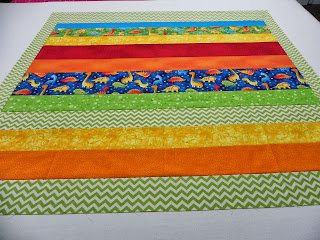.....following on from previous post...
The real point of this exercise (Dinosaur Quilt) is to make some important points about sizing the backing to suit a quilt top.
Here's how to calculate the size of a backing:
1. Measure the Length and Width of the quilt top and jot those measurements down.
2. Add 6 - 8 inches both the length and width and jot those new measurements down too.
Note: if you are quilting your own quilt ie by domestic machine or hand quilting you probably won't need so much extra but, if you are sending your quilt off to a commercial quilter they will (as I will) need at least 3" extra on all four sides.
So having added the extra 6-8 inches you now have the correct size of the backing to fit your quilt top.
If you plan a seamless backing for your quilt and if your quilt is a small cot size, an ordinary width patchwork fabric will be wide enough. So you will only need to purchase the length of the backing.
If, however, the quilt is larger than cot size you will need more than one length, perhaps 1 + 1/2 lengths, 2 lengths, 2 1/2 lengths or even 3 lengths for a king size quilt. Although you might consider a wide backing fabric for the larger sized quilts.
I talk about seaming lengths together on my website go to
http://thequiltconnection.com.au/quilt-preparation/ and print out the PDF titled Quilt Backings...
Okay so getting back to the point of this exercise....
Now that you have calculated the size of the backing required, you can now set about planning a pieced backing to fit, and you can be as creative as you like.
Just a couple of things to remember though, before you start.
1. Plan the piecing so that (as much as possible) the grains go in the same direction. ie lengthwise grain running vertical recommended. For more information about Fabric Grains go to
http://thequiltconnection.com.au/quilt-preparation/.
2. Position any seams in the backing that run parallel to the edges of the backing a distance away from where the edge of the quilt top will be. See photos to follow:
This photo shows my little dinosaur quilt laid out on top of its pieced backing.
Notice that the edge of the quilt top is 1 1/2" away from the seam that joins the ricrac fabric to the sides, the top and the bottom of the backing.
This is the important point!

This photo shows by the outline I've marked, (marked only for demonstration purpose only) where the edge of the quilt top will fall. I should say that it doesn't matter if a seam crosses the edge of the quilt top.
I wonder if you have worked out why I am taking the time to explain all this???
Sooooo....
If a seam is positioned too close to the edge there is a risk that after quilting that seam will end up aligned with the edge of the quilt top and will therefore have to be included in the binding and that would not be a good thing.
Cheers til next time.

















